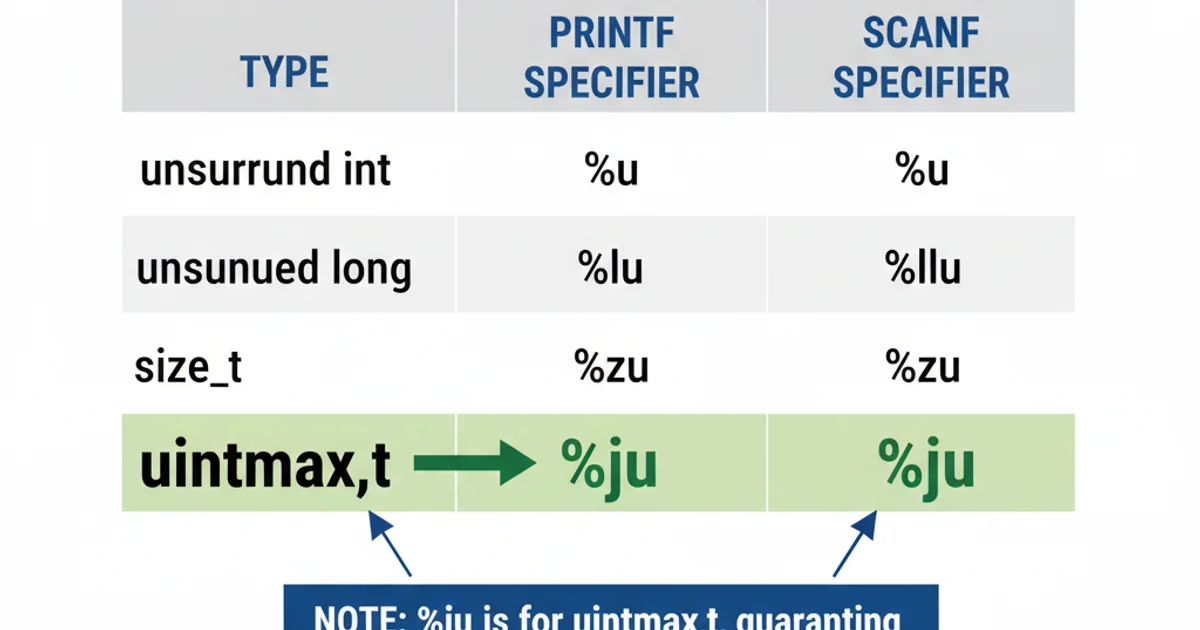Conversion specifier %ju
Categories:
Understanding and Using the %ju Conversion Specifier in C

Explore the %ju conversion specifier in C for printf and scanf functions, specifically designed for printing and reading uintmax_t values. Learn its importance for maximum-width unsigned integer types and how to use it correctly across different platforms.
The C programming language offers a rich set of format specifiers for its printf and scanf family of functions, enabling precise control over input and output. Among these, %ju stands out as a crucial specifier for handling uintmax_t—the maximum-width unsigned integer type available on a given system. This article delves into the purpose, usage, and considerations for %ju, ensuring you can effectively work with large unsigned integer values in your C applications.
What is uintmax_t and Why Use %ju?
The uintmax_t type is defined in <stdint.h> and is guaranteed to be the largest unsigned integer type supported by the C implementation. Its size can vary between systems (e.g., 64-bit on many modern systems, but potentially larger or smaller), making it ideal for scenarios where you need to store the largest possible unsigned integer value without worrying about platform-specific integer sizes.
Using %ju with printf and scanf ensures that the compiler correctly interprets the argument as a uintmax_t. Without the correct specifier, you risk undefined behavior, which can lead to incorrect output, crashes, or security vulnerabilities. This is particularly important when dealing with values that might exceed the range of standard unsigned long or unsigned long long.
flowchart TD
A[Start]
B{Need to handle largest unsigned integer?}
C[Use `uintmax_t` type]
D[Printing to console?]
E[Reading from input?]
F[Use `%ju` with `printf`]
G[Use `%ju` with `scanf`]
H[End]
A --> B
B -- Yes --> C
C --> D
D -- Yes --> F
D -- No --> E
E -- Yes --> G
F --> H
G --> H
B -- No --> HDecision flow for using uintmax_t and the %ju specifier.
Using %ju with printf
When you need to print a uintmax_t value, the %ju conversion specifier tells printf to expect an argument of type uintmax_t. This ensures that the value is correctly formatted and displayed according to its maximum width.
#include <stdio.h>
#include <stdint.h>
int main() {
uintmax_t max_unsigned_val = UINTMAX_MAX; // Maximum value for uintmax_t
uintmax_t large_num = 18446744073709551615ULL; // Example large number (2^64 - 1)
printf("Maximum uintmax_t value: %ju\n", max_unsigned_val);
printf("A large unsigned number: %ju\n", large_num);
return 0;
}
Example of printing uintmax_t values using %ju with printf.
<stdint.h> when using fixed-width integer types like uintmax_t to ensure their definitions are available.Using %ju with scanf
Similarly, when reading an unsigned integer value into a uintmax_t variable, %ju is the correct specifier for scanf. It instructs scanf to parse the input as a maximum-width unsigned integer and store it in the provided uintmax_t pointer.
#include <stdio.h>
#include <stdint.h>
int main() {
uintmax_t input_val;
printf("Enter a large unsigned integer: ");
if (scanf("%ju", &input_val) == 1) {
printf("You entered: %ju\n", input_val);
} else {
printf("Invalid input.\n");
}
return 0;
}
Example of reading uintmax_t values using %ju with scanf.
scanf, always check the return value to ensure that the input operation was successful and that the expected number of items were read. Failure to do so can lead to uninitialized variables or incorrect program behavior.Portability and Alternatives
While %ju is standard C99 and later, older compilers or non-compliant environments might not fully support it. In such rare cases, you might encounter issues. However, for any modern C compiler, %ju is the correct and portable way to handle uintmax_t.
For unsigned long long (which is often, but not always, the same size as uintmax_t), the specifier is %llu. It's crucial not to confuse these; always match the specifier to the exact type to avoid undefined behavior.

Comparison of common unsigned integer types and their format specifiers.